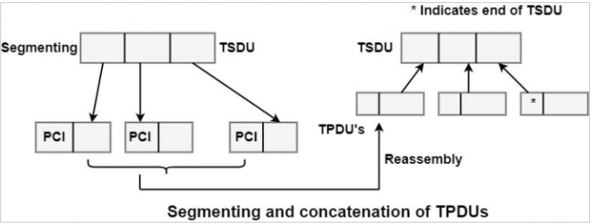The services provided by the transport layer are explained below −
Address Mapping
It means mapping of transport address onto the network address. Whenever a session entity requests to send a transport service data unit (TSDU) to another session entity, it sends its transport service access point address as its identification. The transport entity then determines the network service access point (NSAP) address. This is known as address mapping.
Assignment of Network Connection
The transport entity assigns a network connection for carrying the transport protocol data units (TPDUs). The transport entity establishes this assigned network connection. In some of the transport protocols, recovery from network disconnection is allowed. In such protocols, whenever a disconnection occurs, the transport entity reassigns the transport of TPDUs to a different network connection.
Multiplexing of Transport Connections
For optimum network link uses, the transport entity can create multiple end-to-end transport connections to the network connection, referred to as multiplexing.
There are various TSDUs (multiplexed) identified by the receiving transport entity using the transport connection endpoint identifier (TCEPI), attached to each TSDU by the sending transport entity.
The TCEP identifier is unique for each connection, as shown in the figure below −

Splitting of Transport Connection
When the service quality offered by the network service is less than the required quality of service or when greater resilience is required against network connection failures, then splitting is done by the transport entity. Splitting means TPDUs belonging to one transport connection may be sent over different network connections.
Splitting requires the re-sequencing because it results in the reordering of TSDUs, as shown in the figure shown below −

Establishment of Transport Connection
The transport layer establishes the transport connection by sending a request. For establishing a link, it uses the T-CONNECT service primitives. The transport entity provides the quality of service, requirement, and collect addresses services.
Data Transfer
The transport layer provides the data transfer of two types, such as the regular data transfer and expedited data transfer. In normal data transfer, the user can request to transfer user data with any integral number of octets.
This transfer is transparent, i.e., user data boundaries are preserved during the transfer, and there are no constraints on the content and number of octets. The mode of data transfer can be two ways simultaneously. The expedited data transfer has a distinct control flow, and it can pass all the data queue with maximum priority for delivery. It is a user optional or optional provider service. The number of user data octets is restricted to 16.
Segmentation and Concatenation of TPDUs
The transport entity divides the transport service data unit into several transport protocol data units, each with a separate header containing a PCI (Protocol Control Identifier). This function is known as segments.
This segmenting function is used when the network service cannot support the transport protocol data unit’s size containing an unsegmented TSDU. A reassembly process is performed at the transmitting end for such TPDUs.

The reverse function of segments is known as concatenation. The concatenation enables the mapping of several TPDUs onto a single NSDU (Network Service Data Unit). These TPUs may belong to the same or several transport connections. If they belong to different transport connections, they must be travelling in the exact directions. At the receiving end, a separation function is performed by the transport entity.
The transport entity identifies the boundary of different TPDUs. Concatenation is done for improving the efficiency of utilization of the network service.
On concatenation, there are some restrictions as to which type of TPDUs can be concatenated so that their boundaries should be identified by the transport entity, as shown in the figure below.

Flow Control
The transport entity uses a modified form of sliding window protocol for flow control. This flow control is required because the transport layer may experience back pressure from the network layer.
In the mechanism, the window size is variable and controlled by the receiver. A credit allocated is sent to the receiver’s sender, which indicates how many TPDUs can be received by it.
Error Recovery
The errors at this level can be introduced due to TPDU errors, protocol errors or signal failure conditions of network connections, i.e., reset or release of network connections. Such errors occurring at layer 3 are reported to the transport layer. The TPDU errors can be in the form of lost TPDU, duplicated TPDU, re-ordering of sequence, or content errors.
The duplicate TPDUs are discarded, lost are acknowledged to resend. In the recording, they are re-sequenced, and content errors are detected by incorporating error detection bytes in TPDUs by the transport entity.
Such TPDUs with content errors are discarded and treated as lost, and hence they are also acknowledged. In the case of protocol errors, the connection is released, and in the case of signal failure errors, reassignment of network connection and resynchronization is done.
Sequence Numbering
Each TPDU is given a sequence number by a transport entity that is seven bits long in the normal operations mode. This sequence numbering is done to provide flow control and error recovery. In the case of extended mode, the sequence number can be 31 bits long.
